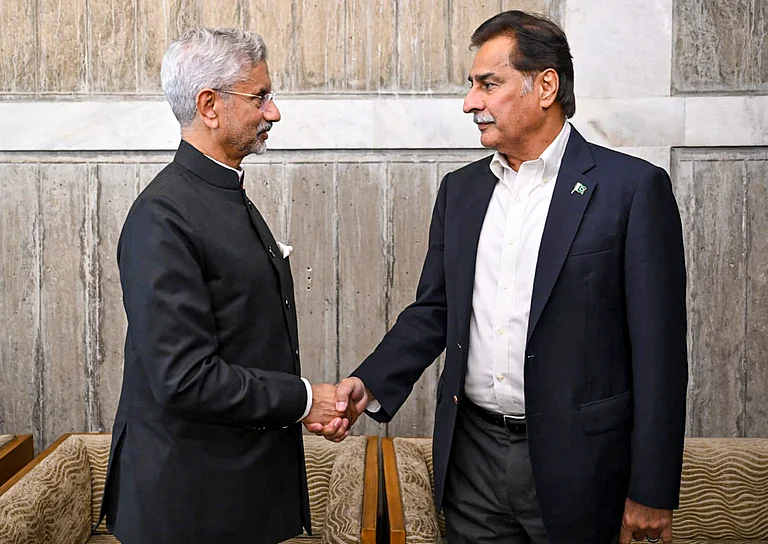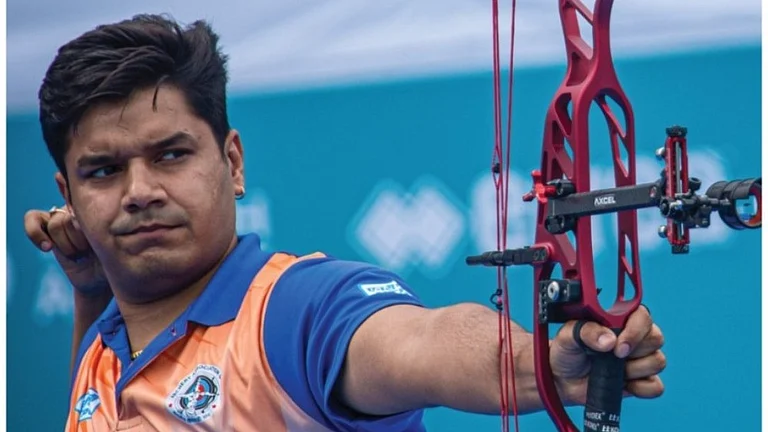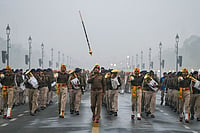News of giving Diwali a swadeshi twist hasn’t trickled down to Star Hotel building at Narain Market in Delhi’s Sadar Bazaar. Days after RSS sarsanghchalak Mohan Bhagwat bemoaned the fact that India has to import even Hindu religious figurines from China, there’s scarcely a dent in the mood at Delhi’s biggest wholesale market. Judging by the swell of shoppers, Sadar traders say they expect more than just brisk business this year. Neither do customers seem to care if their Diwali wares are from China—they’re just after the best deal.
Indeed, as the first boxes of crackers hit the stalls, even top Indian brands (like those pictured) have pasted photos of Chinese children on their made-in-India goods. “Indians are reeling under inflation and high prices. Can one expect them to demand the more expensive Indian stuff? Indians have stopped manufacturing Diwali items. What can people do?” asks Sadar Bazaar trader Harjeet Singh Chhabra. He compares the arrival of Chinese goods with a kind of war without arms. “People talk about the threat from China. But I always say China won’t attack us with weapons when it can stop supplying goods to our markets,” he says. “Everything will collapse.”

Every year around Diwali, festive fineries from the traditional to the bizarre find their way from Chinese factories to retail and wholesale markets. Electric strings of light, statuettes and new items like rotating diyas have shoppers making a beeline, as do illegally imported crackers. Flown in or shipped by importers, dragged on pushcarts, carried on labourers’ shoulders and finally dropped at retail outlets, the made-in-China Indian Diwali is a glitzy sight to behold. Shopkeepers at Narain Market predict a bumper harvest of cash during Diwali 2014. None of them stock ‘made-in-India’ products—a revelation that may disappoint Narendra Modi. Even the traditional earthen diya, traders say, is being ‘researched’ at Chinese r&d centres. Expect a Chinese alternative soon—lighter, inexpensive and unbreakable.
“India’s manufacturing story is over. Except cars, whisky and plastic raw material, practically nothing gets protection. Swadeshi rhetoric and statements mean nothing. Indian manufacturers of Diwali lights are no longer in business, so there’s no question of the government curbing imports from China for their sake,” says Anil Bhardwaj, secretary-general of the Federation of Indian Small & Medium and Micro Enterprises (FISME). Until the late ’90s, FISME members included several electric light makers. Now, most have switched to importing lights from China, where the smallest string costs Rs 75 less than the Indian version once did. A 30-40 per cent difference means the world to Indian consumers.
How the government expects to tackle the issue is anybody’s guess. A Union commerce ministry official explains how import restrictions work. “Only if there is a possible health hazard or big losses to local industry do we consider restrictions. But we have no complaints against Chinese lights. Besides, it’s not as if billions of dollars of lights are coming from China, posing a threat to domestic players,” he says.
As Anil of Toys Hub of Pan Mandi, whose store only sells Chinese goods, puts it, everything costs less if imported from China. “Yeh customer ki demand hai. Sabko Chinese lights hi chahiye,” he says. “The only impact of shouting swadeshi from the rooftop is,” says Chhabra, “putting pressure on traders to lower prices. That’s already happening.”
The light makers may have been burnt out but the cracker manufacturers of Sivakasi in Tamil Nadu are still putting up a spirited fight. This Rs 2,000-3,000-crore industry expects 2,000 container-loads of crackers from China to flood India this Diwali. “You see our own (Sivakasi) traders do this business at various ports; we get reports of supplies from them,” says K. Mariappan, vice-president of the Tamil Nadu Fireworks and Amorces Manufacturers’ Association. Last year, he estimates, 500 to 700 containers floated into India with crackers that may have been 30-40 per cent cheaper, but are more dangerous to use. This year, Chinese cracker exporters are flooding Indian makers in Sivakasi with e-mails, pressing them to import instead.
Unlike Diwali lights, which may be legally imported, Indian laws bar imports of explosives from any country, unless especially licenced. This year, the government issued no Chinese firm a licence for crackers—the move hopes to protect the five lakh-odd Sivakasi manufacturers and workers. It has also cracked down upon cracker importers, as promised by Union minister of commerce Nirmala Sitharaman to a delegation from Sivakasi. “But the crackers need to be destroyed as per law. For this, say states, they don’t have infrastructure,” says Mariappan. Sivakasi’s makers have now offered to destroy imported crackers at their premises, under official supervision.
But a Chinese incursion is tougher to resist vis-a-vis decorations and lights—traders get bigger margins without having to deal with making-in-India obstacles, and buyers only seek Chinese goods, perceived to be low-cost.
That’s why all the talk about swadeshi appears to be just that—talk. If asked, shoppers at Sadar Bazar, Delhi’s biggest wholesale market, stop and think about buying ‘swadeshi’, then go and buy Chinese goods. “An entire generation has been told to think globally. How will they become local overnight? They want to be even more international,” says Chhabra. At home, even Chhabra uses Chinese goods—as does Bhardwaj—as scores of others, regardless of political affiliation. How can they not? “You’d think you’re buying LG, Samsung, Apple; what you’re really buying is made-in-China,” says Bittu Sharma of Chaman Lal and Sons, traders of festival wares. In that sense, the Indian consumer has already internalised celebrating Diwali. Chinese style.


























